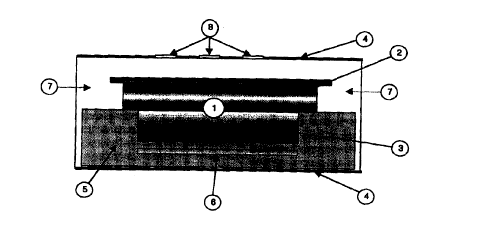Some of the information on this Web page has been provided by external sources. The Government of Canada is not responsible for the accuracy, reliability or currency of the information supplied by external sources. Users wishing to rely upon this information should consult directly with the source of the information. Content provided by external sources is not subject to official languages, privacy and accessibility requirements.
Any discrepancies in the text and image of the Claims and Abstract are due to differing posting times. Text of the Claims and Abstract are posted:
| (12) Patent Application: | (11) CA 2290697 |
|---|---|
| (54) English Title: | SAFETY PACKAGING |
| (54) French Title: | EMBALLAGE DE SECURITE |
| Status: | Dead |
| (51) International Patent Classification (IPC): |
|
|---|---|
| (72) Inventors : |
|
| (73) Owners : |
|
| (71) Applicants : |
|
| (74) Agent: | NORTON ROSE FULBRIGHT CANADA LLP/S.E.N.C.R.L., S.R.L. |
| (74) Associate agent: | |
| (45) Issued: | |
| (86) PCT Filing Date: | 1999-03-12 |
| (87) Open to Public Inspection: | 1999-09-23 |
| Examination requested: | 2003-12-16 |
| Availability of licence: | N/A |
| (25) Language of filing: | English |
| Patent Cooperation Treaty (PCT): | Yes |
|---|---|
| (86) PCT Filing Number: | PCT/SE1999/000391 |
| (87) International Publication Number: | WO1999/047881 |
| (85) National Entry: | 1999-11-16 |
| (30) Application Priority Data: | ||||||
|---|---|---|---|---|---|---|
|
Packaging for volatile, heat-sensitive products, said packaging eliminating
all dangerous effects of chance ignition during transport and storage by
enabling control of the order in which the various packed components
disintegrate when the packaging is exposed to external fire. A sample
application for the packaging is the packing of airbag modules: the airbag can
be rendered harmless by decomposing (under the influence of heat) before the
gas generator ignites. The volatile, heat sensitive component (3) which is to
be protected is placed in a thermally insulating material (5) while the
insensitive component is left unprotected. Both the product (1) and the
thermally insulating bed (5) are placed in a protective container (4). Gases
are vented from the purpose-designed and dimensioned protective container (4)
after they have escaped via the openings (7). This prevents randomly acting
gases giving rise to unidirectional, reaction forces.
L'invention concerne un emballage destiné à des produits thermiquement instables et permettant de supprimer tous les effets dangereux d'allumages provoqués par accident pendant le transport et le stockage. L'emballage est conçu de telle façon que l'on puisse déterminer l'ordre de désintégration des différents composants emballés en cas d'incendie extérieur. Citons, par exemple, les modules airbags dont le sac est détruit par décomposition sous l'action de la chaleur avant que le générateur de gaz ne s'allume. Le composant sensible à la chaleur (3) devant être protégé est placé dans un matériau thermiquement isolant (5), tandis que le composant insensible (2) reste non protégé. Le produit (1) et la couche thermiquement isolante (5) sont placés dans un contenant protecteur (4) après s'être dissipés par les trous (7), ce qui empêche les gaz agissant au hasard engendrant des forces de réaction unidirectionnelles.
Note: Claims are shown in the official language in which they were submitted.
Note: Descriptions are shown in the official language in which they were submitted.

For a clearer understanding of the status of the application/patent presented on this page, the site Disclaimer , as well as the definitions for Patent , Administrative Status , Maintenance Fee and Payment History should be consulted.
| Title | Date |
|---|---|
| Forecasted Issue Date | Unavailable |
| (86) PCT Filing Date | 1999-03-12 |
| (87) PCT Publication Date | 1999-09-23 |
| (85) National Entry | 1999-11-16 |
| Examination Requested | 2003-12-16 |
| Dead Application | 2006-03-13 |
| Abandonment Date | Reason | Reinstatement Date |
|---|---|---|
| 2002-03-12 | FAILURE TO PAY APPLICATION MAINTENANCE FEE | 2002-04-11 |
| 2005-03-14 | FAILURE TO PAY APPLICATION MAINTENANCE FEE |
| Fee Type | Anniversary Year | Due Date | Amount Paid | Paid Date |
|---|---|---|---|---|
| Application Fee | $150.00 | 1999-11-16 | ||
| Registration of a document - section 124 | $100.00 | 2000-01-12 | ||
| Maintenance Fee - Application - New Act | 2 | 2001-03-12 | $50.00 | 2001-02-13 |
| Reinstatement: Failure to Pay Application Maintenance Fees | $200.00 | 2002-04-11 | ||
| Maintenance Fee - Application - New Act | 3 | 2002-03-12 | $100.00 | 2002-04-11 |
| Maintenance Fee - Application - New Act | 4 | 2003-03-12 | $100.00 | 2003-02-17 |
| Request for Examination | $400.00 | 2003-12-16 | ||
| Maintenance Fee - Application - New Act | 5 | 2004-03-12 | $200.00 | 2004-03-10 |
Note: Records showing the ownership history in alphabetical order.
| Current Owners on Record |
|---|
| TEAM SAFEPAC I KARLSKOGA AB |
| Past Owners on Record |
|---|
| BENGTSSON, TOMMY |
| LARSSON, ANDERS |
| SANDBERG, THOMAS |